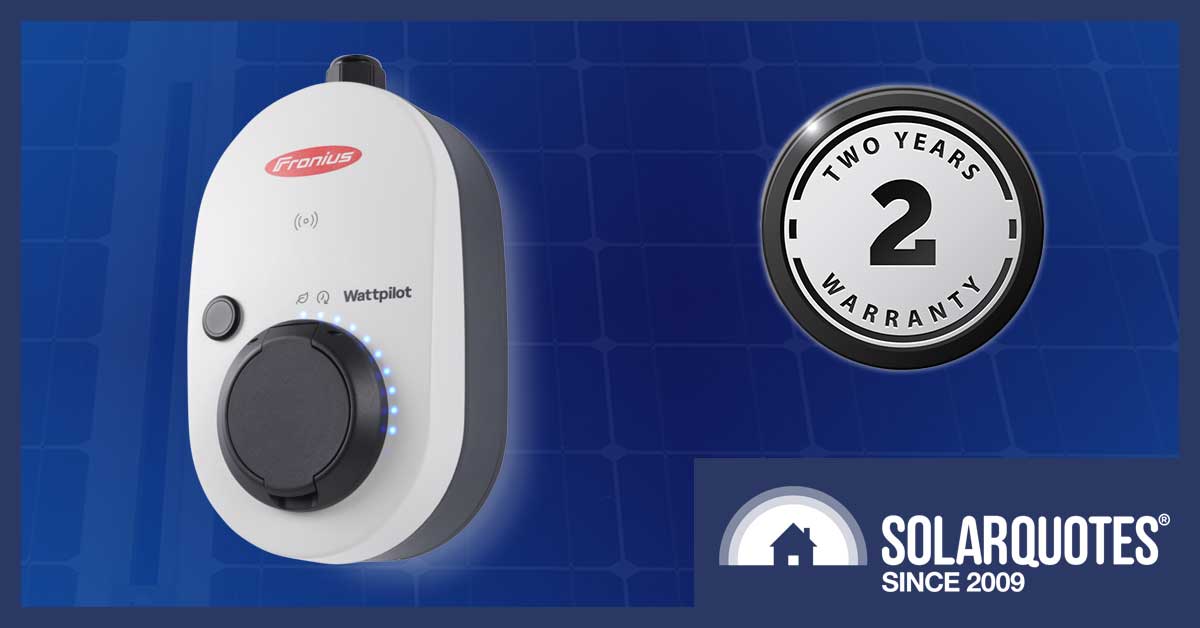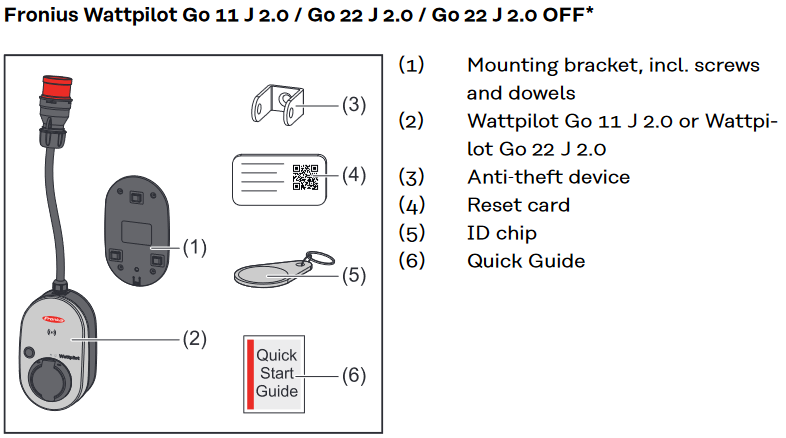
This is a deep dive into the Fronius Wattpilot EV charger warranty. If you don’t know what that is, it’s a device for charging EVs.
There is nothing especially wrong with the warranty Fronius provides — except that it’s too short. The Wattpilot warranty is only two years.
This isn’t unusual, but I think a company like Fronius, with a good reputation for reliability, should be the leader of the pack instead of hanging back with the two-year rabble.
If you want to know what the hell a Fronius Wattpilot EV charger is, I dive into the Wattpilot’s specifications here.
What’s a Wattpilot?
A Wattpilot is an EV charger1 produced by the Austrian company Fronius. Their solar inverters have a good reputation in Australia, so I expect the Wattpilot to be well-made and reliable.
There’s a portable version called the ‘WattPilot Go’ you can carry around, and the ‘Wattpilot Home’ gets hardwired into the wall.
You can see how it compares to others on the market with our EV Charger Comparison Table.
How To Find The Warranty
If you go to the Fronius site and search for “Wattpilot warranty”, the result will be – as Americans say – a nothing burger. Translated into Australian, it’s an empty meat pie. Fronius uses the same warranty document for all the products they sell in Australia, so there’s no separate one for the Wattpilot.
Finding The Fronius Australia Warranty Document
You must go to the Fronius Australia Site, then Click ‘Downloads’, then search for ‘Warranty’ and then click on “Fronius Warranty Terms & Conditions AU / NZ“.
Finding the Operating and Installation Instructions
The Wattpilot must be installed and used according to its Operating Instructions, so you should download that too. Go back to the download page, search ‘Wattpilot’ and click “Fronius Wattpilot Go 11 J 2.0 / Go 22 J / Go 22 J AU“.
Ensure it has the “AU” on the end since that stands for AUstralia. Also, unless you’re a polyglot, click on the ones marked “EN” for English.
Contact Your Installer First
If there is a problem with your Fronius Wattpilot, contact your installer first. They’re the ones who took your money and are responsible for ensuring it works. Let them deal with Fronius if that’s necessary. But you can contact Fronius directly if your installer is no longer around.
What The Warranty Covers
The warranty document says a Wattpilot warranty claim can be made if – and only if…
- It has a material or manufacturing defect that is Fronius’s fault.
But it’s not enough. The defect must…
- Affect the operation of the Wattpilot.
And it also doesn’t count if you’re doing anything weird…
- The defect [must occur] during the normal use of the covered product.
And finally…
- None of the many exclusions in the warranty apply.
So even if the Wattpilot has an obvious fault — say it squawks like a cockatoo when in use — Fronius could say the warranty doesn’t apply if the noise doesn’t affect its operation. While this seems completely unreasonable, unreasonable warranty conditions are common. But the good news is that, unlike warranty-writing lawyers, Fronius Australia are good eggs. They’re generally reasonable when resolving issues, even if their warranty doesn’t technically cover them.
So while the Fronius warranty conditions sound strict, they are typical of most EV charger warranties. You also have additional protection starting with your installer, followed by Fronius customer service and – potentially – ending with Australian Consumer Law which states products must be “safe, durable, and free of defects”.
After that comes vigilante justice, but I don’t recommend it. Unless you’re Batman.
Excluded Components
One unfortunate fact about Fonius warranties is they come with a list of components that aren’t covered.
Here’s what they exclude:
“Components of covered products that are subject to regular wear and tear. These include DC isolators, fuses, bayonet connectors, varistors, surge arresters, string fuses and mechanical screw connections if they are not properly tightened to the correct torque during installation.”
On the bright side, there’s not much in the way of specifically listed excluded components that come with a Wattpilot:

What you get with a Wattpilot Go. The Wattpilot Home is similar, except there’s no plug on its cord because it’s hardwired.
On the dark side, the warranty’s wording doesn’t prevent Fronius from saying other components are also “subject to significant wear and tear”. So they could claim the Wattpilot socket gets significantly worn and torn — or perhaps the plug on the portable version.
Exclusions Galore
As is typical, the Fronius warranty has many exclusions that render it void.
Most of them boil down to:
- The Wattpilot must be used according to its installation manual.
- It must be used normally, e.g. for charging EVs — not giant battle robots.
- It can’t be hacked or modified or given unauthorized repairs.
- The warranty doesn’t cover anything that isn’t directly Fronius’s fault.
One exclusion I’ll specifically mention is:
“No claims for energy that has not been fed into the grid or energy that has not been used for self-consumption, etc.”
This means that if the Wattpilot fails to charge your Hyundai Ioniq 6 EV2 with solar energy like it was supposed to, the warranty won’t cover any loss of money that results.
Wattpilot Doesn’t Need Internet Updates, But Fronius Inverters Do
These days even some toothbrushes want to be connected to the internet and receive updates3 and warranties can require this. Fortunately, the Wattpilot does not need an internet connection for updates. But if you use it with a Fronius inverter, the inverter will. The Fronius warranty says it must be either connected to the internet so it can be updated, or you must otherwise regularly provide it with updates. You can read about Fronius inverter warranties here.
No Warranty Extensions
Fronius likes to sell warranty extensions for its inverters. This may be why its inverter warranties aren’t as long as I think they should be — they want you to pay for them. But warranty extensions aren’t available for the Wattpilot.
It’s Transferrable
If you have a Wattpilot home and you sell the property where it’s installed, you can transfer the warranty to the new owner. But the warranty says gives the requirement that…
“The covered product is not removed from the place of first use.”
That’s a bit of a strange requirement for the Wattpilot Go, since it’s portable.
What Fronius Will Do
If you make a claim that’s covered by the warranty, then Fronius says they get to decide which of the following three things they will do:
- Repair the Wattpilot.
- Replace the Wattpilot with “…an equivalent unit of the same age, type and condition.”
- Pay you off — but not with money. Instead, “A credit note is issued for the market value applicable at the time of the service notification, which can be used to purchase a new FRONIUS product.”
Personally, I would not want Fronius bucks. For one thing, the “market value” of a used Wattpilot may be much less than what you paid new.
In reality, what’s most likely to happen is you’ll get a replacement unit.
What Fronius Doesn’t Have To Do
According to the warranty, Fronius doesn’t have to pay for the cost of labour to replace a Wattpilot. As the Wattpilot Go is portable, this will mainly apply to the hardwired Wattpilot Home.
The warranty also says it doesn’t cover transport costs for returning units to Fronius or travel costs for repair people. They also say if technology change renders a replacement incompatible with anything, they won’t cover any related costs.
Fortunately, you are protected by more than just the Fronius warranty.
You Are Protected By Australian Consumer Guarantees
As mentioned earlier, you are protected by Australian Consumer Guarantees which don’t end when a product’s warranty does. Given that a smart EV charger like the Wattpilot costs around $2000, I think it’s very bloody reasonable for people to not be out of pocket if it breaks down after just two and a bit years.
You can also claim for reasonable losses from a faulty product, such as labour and transport costs. And despite any Fronius small-print, it’s also possible to claim for losses from reduced solar self-consumption from your Wattpilot being out of action.
Not Bad, But It Could Be Better
While the Wattpilot warranty isn’t bad compared to the low standard set by other EV chargers on the market, I am disappointed that a big-name company like Fronius, with big Austrian energy, can’t do better than a 2 year warranty.
Fronius should be confident enough in its ability to design a decent charger to at least give it a warranty that’s longer than average – ideally ten years.
Footnotes
- Technically it’s not a charger; it’s more a charger assistant, with the actual charger being in the EV. But it’s not my fault that’s what everyone calls them. ↩
- Hey, Hyundai! I’d really like to test drive one of them! Of course, I may need three or four years of test driving to get the full experience… ↩
- My Xbox has trained me never to use it by insisting on spending 4 hours updating on the rare occasions I decide to play a game. ↩

 RSS - Posts
RSS - Posts



I wonder if the gov should make EV ‘chargers’ available for STCs, as long as the warranty is 5+ years and there’s capability for demand response?
Would need to have mechanisms to ensure prices don’t just go up by the size of the subsidy, but that shouldn’t be too difficult.
The federal government may introduce zero interest loans for EV chargers, so that’s one type of subsidy that may become available. Technically, EV chargers can’t get STCs because they don’t produce energy, but they can be use to support the grid by providing a load when its needed by charging EVs. It can be possible to be paid to charge your EV when wholesale electricity prices are negative under the right circumstances, although its still early days for this sort of thing.
UPDATE: I see wholesale electricity costs negative 5 cents in South Australia at the moment. So if you charged an EV with 10kWh at that price you could earn 50 cents. That’s not a huge amount, but it is infinitely better than paying for petrol.
Yeah not sure of the subsidy mechanism, but having a subsidy that requires a good warranty and mechanism to avoid peak charging makes sense.
Something similar to what Vic Gov now require for heat pumps, but preferably with a bit more smarts than a basic timer:
https://www.solarquotes.com.au/blog/solar-victoria-2023-rules/
Interested in how the watt pilot tracks the excess solar during intermittent cloud days – how fast it ramps up and down the charge rate when the sun goes behind a cloud and pops back out again? I’m currently using a gen 3 Tesla charger with charge HQ. With my setup I tend to only get about 85-90% solar into the car and 10-15% from the grid on intermittently cloudy days due to the delay before the charge rate drops when the sun goes behind a cloud, and visa versa when the sun comes back out (Charge HQ only polls the fronius smart meter data every couple of minutes I believe). Wondering if it’s worth swapping the Tesla charger for a watt pilot instead if the charge rate changes are more instantaneous? Cheers, Simon